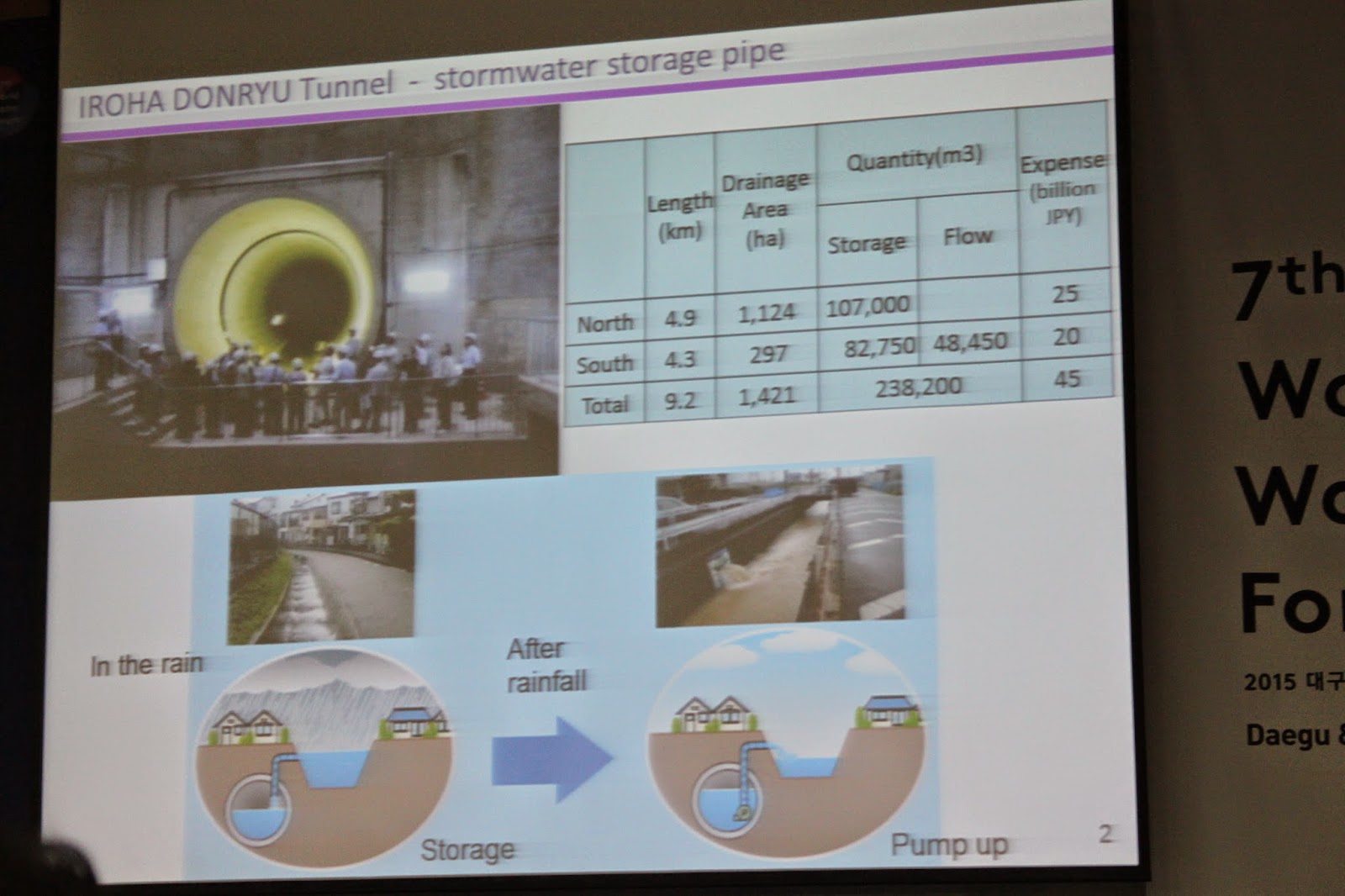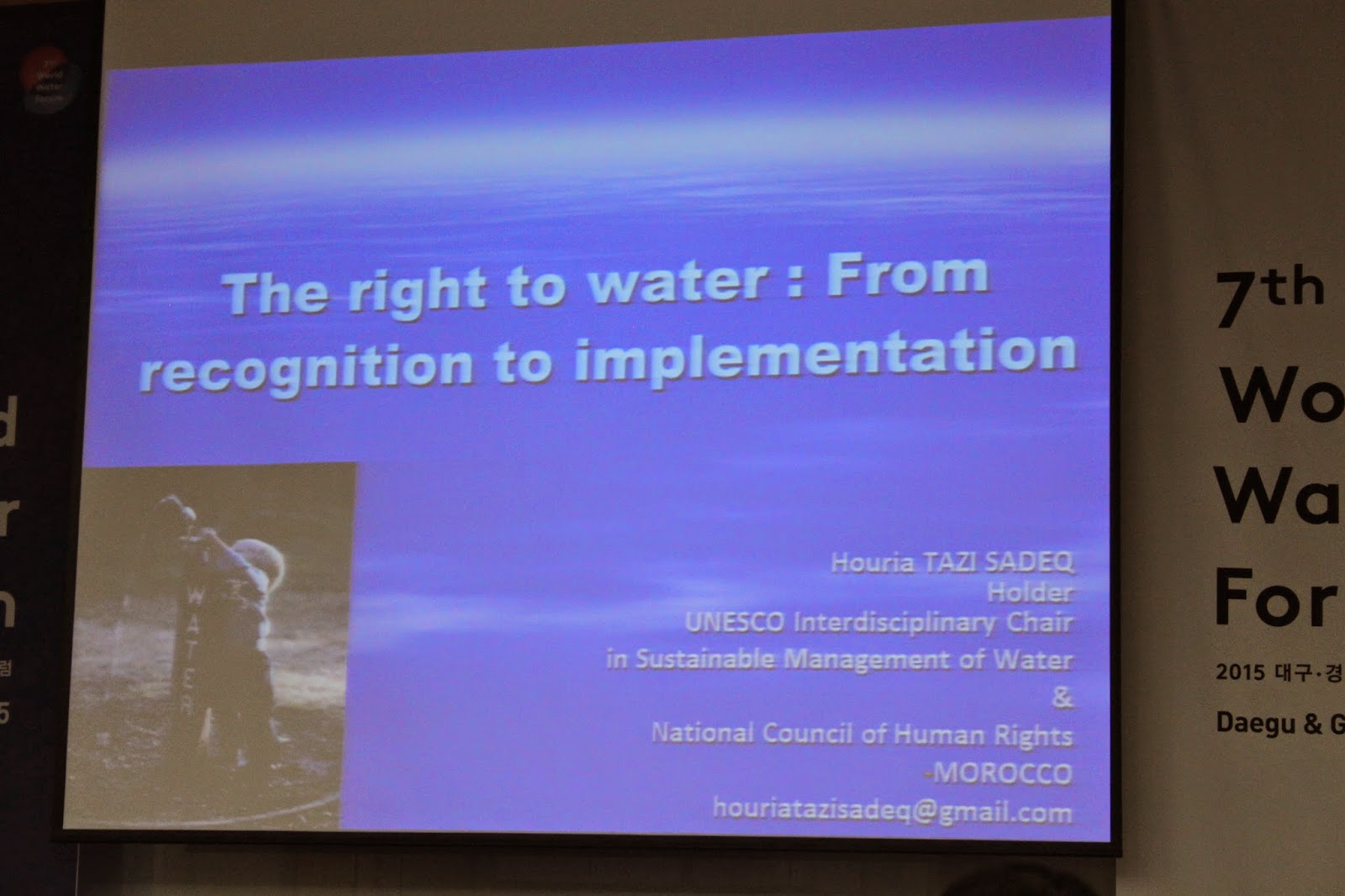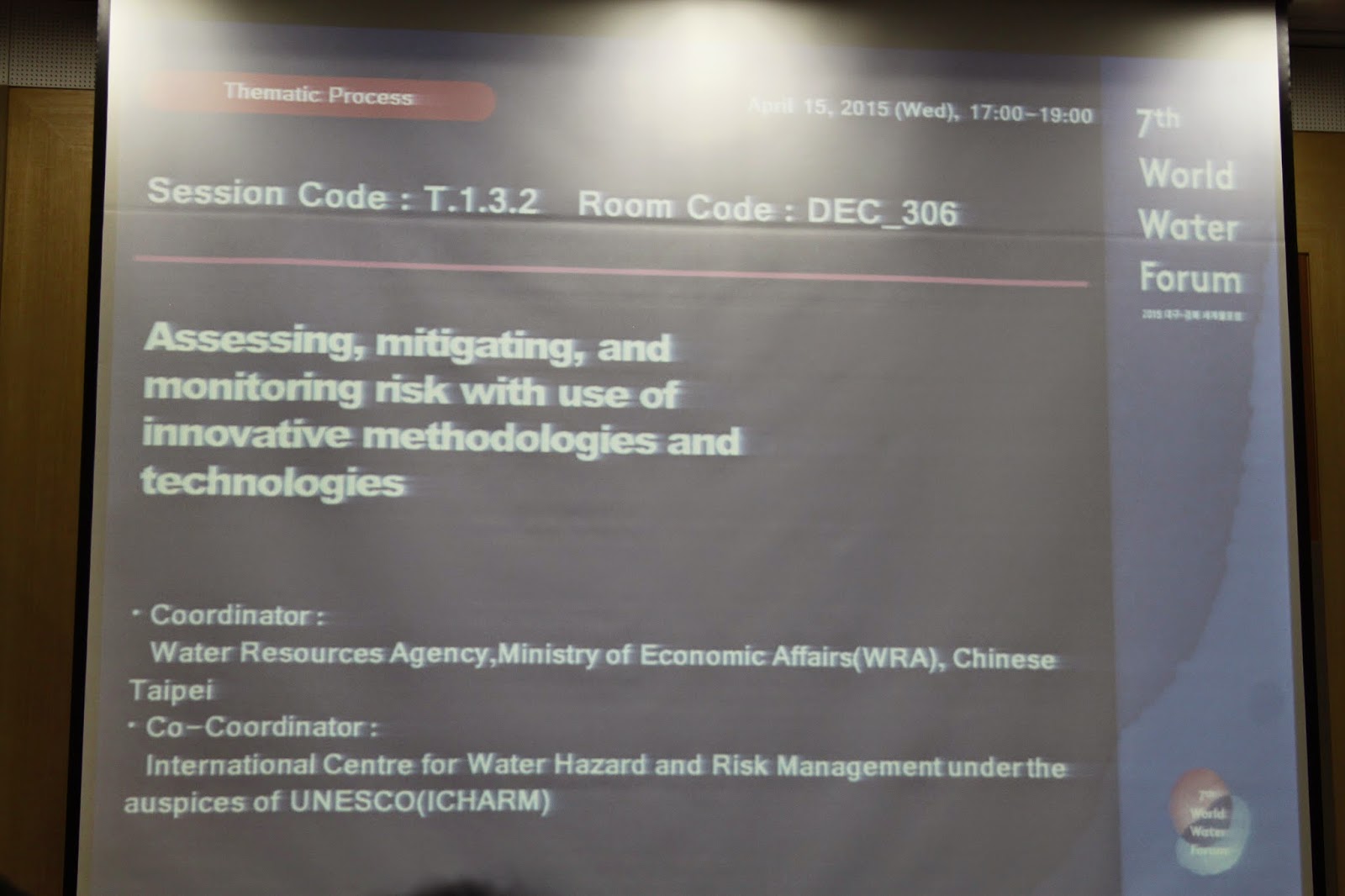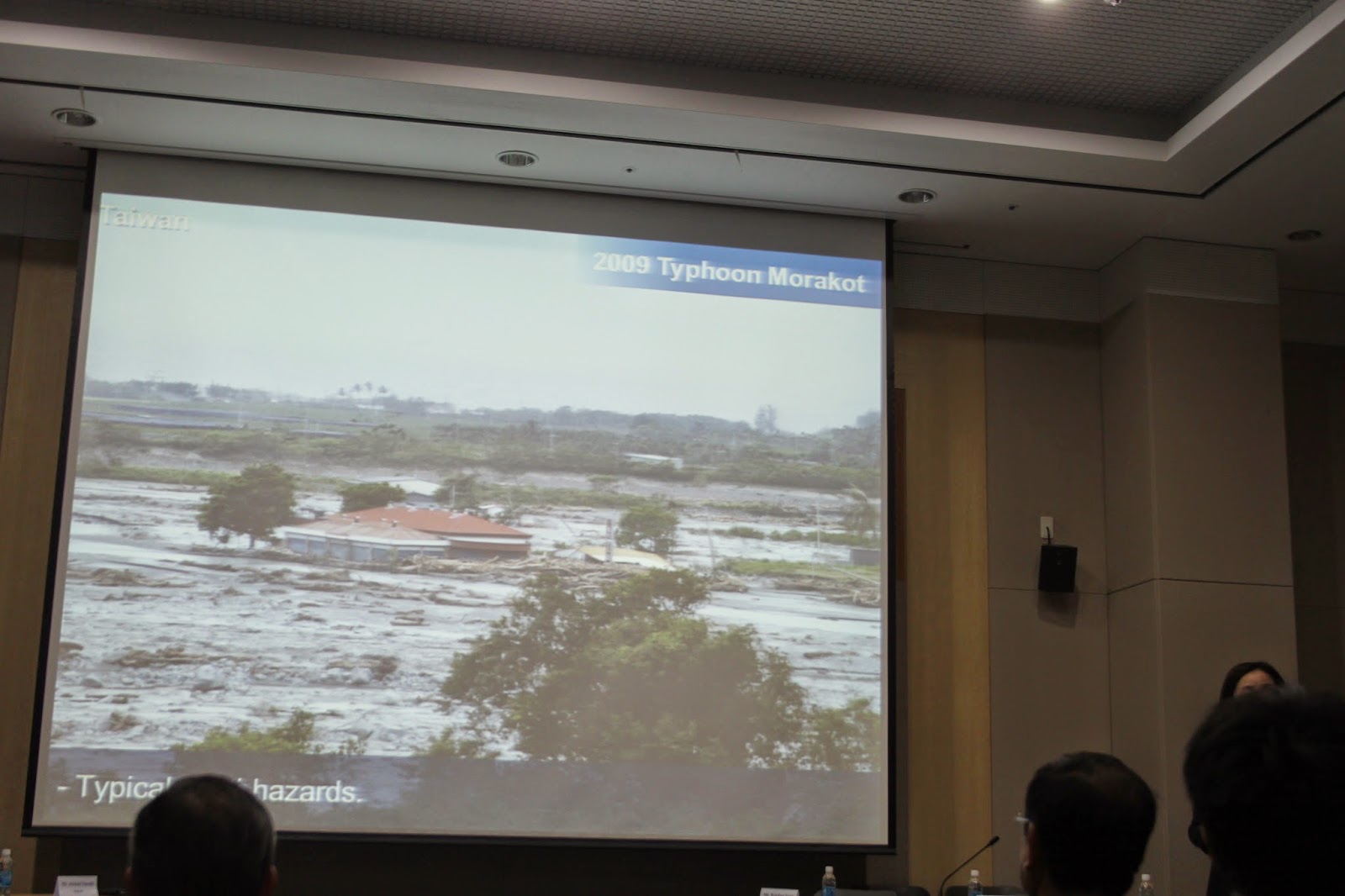7th World Water Forum in Daegu and Gyeongju, Korea - day 4
There was time to visit three sessions today in Daegu, on the topics of water justice, governance indicators, and monitoring risks.
Session T.4.4.4 Water justices and cooperation: perspectives and frameworks for fostering cultural diversity, society and nature
This session was organized by the UNESCO International Hydrological Programme and the Water Justice Alliance, and attended by approximately 40 people.
Agenda:
1. (5 min) Introduction by the moderator: Alexander Otte
2. (12 min) Legal diversity and participation: local, national and international water rights systems: Mara Tignino, Platform for International Water, University of Geneva, Law
3. (12 min) 1/ Whose right for which water? 2/ Governance, political and legal dilemmas: Tatsuro Nikawa & Tsugihiro Watanabe, Citizen Network of Japan
5. (12 min) Legal frameworks, diversity and education: striking the balance at the political level: Miguel Correa, Secretary of Higher Education of Minas Gerais, Brazil
6. (12 min) The UN Declaration on the Rights of Indigenous Peoples: which impact on water issues?: Mona Polacca, Indigenous World Forum for Water and Peace
7. (12 min) International legal frameworks: the example of the UNECE Water Convention: Chantal Demilecamps, UNECE
3. (12 min) Human right to water: meaning, scope, obligations: Judith Serrano, Research Professor, Colegio de Mexico in the Center for Demographic, Urban and Environmental Studies
8. (12 min) Constitutional human right to water: the example of Morocco: Houria Tazi Sadeq, Human Rights Council of Morocco
9. (25 min) Discussion with the audience: All participants/moderator
10. (10 min) Wrap-up and messages for IR: Moderator
Objective: This session will present scientific and practical approaches to conceptual and legal frameworks regulating the hydro-social sphere. In presentations and discussions, the participants will explore how those frameworks and their implementation can foster water cooperation, justice, cultural diversity and more harmonious interactions of society and nature? all of which is of fundamental importance for sustainable development. The session will concentrate on diverse perspectives on water, water rights, legal frameworks and how they can be better understood and embedded in cooperative mechanisms, from public participation to international conventions.
Session excerpts: In Japan we should drink lake water which is not purified, as it is healthy. Mountain water has traditionally been used as drinking water without further purification.
Session T.4.2.6 Counting what counts: getting indicators right for better water governance
This session was organized by the Organisation for Economic Co-operation and Development (OECD), and attended by approximately 40 people.
Agenda:
1) 11h20-11h30: Setting the Scene by Teun Bastemeijer [WIN]: Processes, assessments and indicators ? Concepts, contexts and action learning
2) 11h30-12h10: Water governance indicators: Taking stock of what exists
Chaired by Aziza Akhmouch , OECD Water Governance Programme
- Objective: The panel will aim to gather experts to share their experience in building up water governance indicators and to discuss possible challenges in finding measures in an incomplete information environment, such as that of water governance.
- Expected outcomes: Update the inventory of water governance indicators and investigate synergies with the implementation of a water SDG in the post-2015 development agenda.
Panellists:
- Donal O’Leary [Transparency International]: Assessing Water Governance Performance and Indicators: A Civil Society View
- Tadashige Kawasaki [NARBO]: Performance benchmarking for RBOs
- Sophie Tremolet [WHO]: UN-Water GLAAS, Tracking financing to sanitation, hygiene and drinking-water at national level
- Thomas Panella [ADB]: Water Security Index
- Betsy Otto [WRI]: Aqueduct, a global water risk assessment and mapping tool
- Gareth James Lloyd [UNEP-DHI]: Monitoring and reporting system on IWRM in support of a possible Sustainable Development Goal target on IWRM
- Aline Machado da Matta [National Water Agency, Brazil]: Water management map
- Rui Cunha Marques [Portuguese Water Partnership]: How to watch the watchmen: The role and measurement of regulatory governance
- Karin Krchnak [WWF International]: River Basin Score Card fact sheet
3) 12h10-12h30: Q&A, Discussion with the audience
4) 12h30-13h00: Parallel Roundtables on challenges and opportunities to measure water governance
- Objective: Each table will discuss a specific aspect of water governance and will contribute to answer the following questions for improving water governance measurement:
- What to measure?
- At which scale should the indicators be defined?
- How to build up the indicator?
- Who are the recipients?
- Whose views should be relied on?
- How to ensure the replicability of the indicators?
- How should information be disclosed?
- Expected outcomes: Agreement on the implementation roadmap to follow the implementation of the 12 Principles with a view to contributing to the 7th World Water Forum Action Monitoring System.
Roundtables:
1. Measuring fragmentation and vertical and horizontal coordination - Moderated by Oriana Romano [OECD]
2. Measuring efficiency of RBOs - Moderated by Alain Bernard [INBO]
3. Measuring intersectoral coherence - Moderated by Teodoro Estrela [Ministry of Agriculture, Food and the Environment, Spain]
4. Measuring capacity - Moderated by Chris Seijger [Deltares]
5. Measuring the governance-financing nexus -Moderated by Francisco Gonzalez Medina [AECID/FCAS]
6. Evaluating the evaluator [indicators on regulation] - Moderated by Jaime Melo Baptista [ERSAR]
7. Assessing governance obstacles to innovation - Moderated by Ed Pinero [Veolia]
8. Assessing integrity and transparency -Moderated by Hakan Tropp [ SIWI]
9. Measuring stakeholder engagement - Moderated by Gul Ozerol [University of Twente]
5) 13h-13h15: Report back to plenary
Discussion with the audience
6) 13h15-13h20: Next steps
Objective: The last decade has witnessed multiple attempts at developing indicators for measuring various aspects of water governance, in search for greater transparency and accountability. But this can be a daunting task because of a number of challenges related to the complexity of the sector, the incompleteness of the information environment, but also the uncertainty of the context and difficulties to establish causality. Policy makers have indeed limited control on environmental, economic and social factors that might affect water governance. As Einstein said “Not everything that counts can be counted and not everything that can be counted counts”. The session will discuss existing tools for measuring water governance and challenges and opportunities to move towards more systemic frameworks to assess the performance of water governance at different levels
Session excerpts:
Akhmouch: AT 6th WWF 6 targets were made for indicators.
Bastemeijer: Indicators should reflect sustainability. The logical consequence is to make differential indicators for all 12 principles. No sustainability without equity.
Kawasaki: ADB funds river basin indicator development in Asia.
Chris Sijger, Deltares: There are subjective and objective indicators when it comes to governance's own monitoring.
Baptista, Portugal: Guarantee and validify the data. We should have a tool to assess all public policy, not just water policy. Indicators are only the first step, leading to knowledge. Then you should take the next steps.
Session T.1.3.2 Assessing, mitigating and monitoring risk with use of innovative methodologies and technologies
This session was organized by the Water Resources Agency, Ministry of Economic Affairs(WRA), Chinese Taipei and co-organized by ICHARM, and attended by approximately 80 people.
Participants:
Wei-Fuu Yang, Vice Minister/Director-General, WRA, Chinese Taipei
Atsushi Suzuki, Deputy Director, ICHARM
Director Philippe Gourbesville, Univ. Nice Sophia Antipolis, France
Wei-Fuu Yang, Vice Minister/ Director-General, WRA, Chinese Taipei
Yoichi Iwami, Chief Researcher, ICHARM
Ms. Ayse YILDIRIM COSGUN, Head of Division, Ministry of Forestry
Hisaya Sawano, Chief Researcher, ICHARM
Professor Ke-Sheng Cheng, National Taiwan University
Objective: This session will explore the innovative methodology and technology application in multi-hazard assessment, mitigation, and monitoring based on the experiences from multi-regions, such as Asian-Pacific and European countries. The session will present the utilization of methodologies in understanding and analyzing the water-related risks, and technologies in providing effective preparation and efficient responses. The cases proposed in this session will cover the aspects of sediment disaster, flooding, typhoon and hurricane, watershed management, and multi-hazard reduction/recovery and include good practices to be applied to other cases.
Session excerpts:
Wei-Fuu Yang, Vice Minister/Director-General of WRA, Chinese Taipei opened with the news that the worst drought in 60 years is now occurring in Taiwan.
The welcome remarks were from Atsushi Suzuki, Deputy Director at ICHARM, who explained we are at a crucial turning point due to the political process of the documents created at conferences this year. Among these are the results from the Sendai World Conference for Disaster Risk Reduction from last March, the Post 2015 development agenda meeting in September, and the UNFCCC meeting in December. Methodologies and technologies are indispensable for DRR, and these case studies presented during this session will be a great example for this World Water Forum.
Director Philippe Gourbesville from the university of Nice Sophia Antipolis, France, presented “The methodology and implementation in flooding vulnerability analysis and risk assessment”. They developed a flood risk index for each house in the city Nice, and had similar dynamic simulation projects in Mexico city, Algiers, and Vietnam.
Gloria Lin presented on the topic of “the application of Multi-hazard mitigation and prevention technology in Chinese Taipei”, with the most interesting technical product being Q-Water, a product designed originally to aid people in remote areas such as mountain villages or small islands to get safe drinking water. This system can also be applied in developing countries. In Taiwan, the Seven Eleven convenience stores help report on disaster severity.
Yoichi Iwami, Chief Researcher at ICHARM, presented on “Integrated flood management in the context of climate change” by showing several examples of typhoons. ICHARM aids developing countries with the free Early Warning System software IFAS, which imports global satellite data and ground gauged data to calculate river discharge, water level and rainfall distribution, and provide warnings. He also showed how the Rainfall Runoff Inundation model works and was applied in Pakistan, and to the Chao Praya river, which is now available on the Royal Thai website.
Ayse Yildirim Cosgun, Head of Division from the Ministry of Forestry and Water Affairs, Turkey presented on “Climate change impacts on Turkish water resources from the perspective of risk management”. She explained how climate risks were calculated, e.g. with water available vs water used per river basin.
Hisaya Sawano, Chief Researcher at ICHARM, presented the topic of “Development of flood risk information and data”. He introduced data collection and analysis methods, such as C-band/x-band radar system, real time and high resolution image data, including a network of observatory systems, advanced hydrologic simulations with telemetry systems and topographical survey data. Next were lists of the currently used global data in ICHARM. What information is missing in water related disaster risk management? We need to develop archives of damages, and perform flood disaster risk assessment by identifying hazards, risk assessment by checking socio-economic damages, mortality etc. He showed how Japan is arranging these data and had two heavy rain cases in Japan, Tokai and Fukuoka, identifying the saved costs of implemented measures. Next were ICHARM activities in Philippines, where a RRI model was applied to identify the inundation area. A flood in 2011 was used to verify the simulation model. Rice crop damage was calculated depending on the stage of growth and yields. Finally, he argued why flood risk assessment is necessary, and how ICHARM can assist developing countries.
Professor Ke-Sheng Cheng from the National Taiwan University presented on the topic of “Stochastic risk assessment of extreme rainfalls under climate change” and showed integrated stochastic approaches for Global Climate Models and climatologic projections.
During the panel discussion, led by Prof. Cheng and Prof. Imamura, Sawano was asked how we can ensure that the local government has enough technology and resources to take action. He answered that capacity should be developed based on the defined roles and responsibilities. National government provides support and training, but local government often also organizes a self-defense team, with a kind of indigenous knowledge and experience. A big event such as a tsunami exceeds the local capabilities, so the national government should also have a role. There should be clearly defined roles and sharing of responsibilities. Director Gourbesville added that we should innovate at the local level, at the country level we know how to gather information. The failure is always at the local level, there is nothing at the scale between city and house, where you are affected for several days. We need to develop implementation for this. Lin added that in Taiwan data is collected from convenience stores because the gauging stations are limited, but we need to know the inundation depth. We cooperate with the convenience stores as they are almost everywhere, and they can look at e.g. car tires to estimate the depth, we train their employees how to recognize it and tell us.
Professor Imamura posed a question to Yildirim Cosgun, namely how do you prepare for a prediction of heavy drought? She answered that the precipitation will stay the same, but the distribution will differ per region. The South is getting dryer, other regions will have higher rainfall amounts. These then balance themselves. The follow up question came “How will we make the institutions apply these impacts?” She replied that we have a climate change board consisting of all undersecretaries of ministries who meet four times a year. The decisions of these meetings are a sort of law. All ministries have to apply the decisions made.
Given the active questions from the audience and panel discussion, this session was highly successful in distributing ideas and stimulating thoughts between participants.



































































































No comments:
Post a Comment